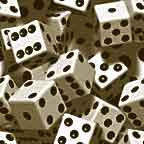



 |
 |
 |
 |

All numbers in this article are in base twelve; T stands for T and E for eleven; the "dozenal point" is represented by an apostrophe.
If we throw a six-sided die the chance of throwing the number six is simply one in six (assuming, of course, that the die is fair).
One Die (6 outcomes)
| Score | ways | chance |
|---|---|---|
| 1 | 1 | 0'2 |
| 2 | 1 | 0'2 |
| 3 | 1 | 0'2 |
| 4 | 1 | 0'2 |
| 5 | 1 | 0'2 |
| 6 | 1 | 0'2 |
| totals | 6 | 1'0 |
The game of Craps uses two dice; the player rolls the two dice and adds the numbers shown on the dice to make his score. The least he can score is 2 (with both dice showing "1") and the most 10 (both showing "6").
The scores gained by throwing two dice are shown in the table:
| Die 2 | ||||||
| Die 1 | 1 | 2 | 3 | 4 | 5 | 6 |
| 1 | 2 | 3 | 4 | 5 | 6 | 7 |
| 2 | 3 | 4 | 5 | 6 | 7 | 8 |
| 3 | 4 | 5 | 6 | 7 | 8 | 9 |
| 4 | 5 | 6 | 7 | 8 | 9 | T |
| 5 | 6 | 7 | 8 | 9 | T | E |
| 6 | 7 | 8 | 9 | T | E | 10 |
There are more ways of throwing a "7" than any other number; of the 30 possible results 6 of them are a "7"; 6 out of 30 is one-sixth, or 0'2, or 20 per gross. (Note how base twelve makes the numbers simple; because of the factor 6.)
Two dice (6^2 = *30 outcomes)
| score | ways | chance | per gross |
|---|---|---|---|
| 2 | 1 | 0'04 | 4 |
| 3 | 2 | 0'08 | 8 |
| 4 | 3 | 0'10 | 10 |
| 5 | 4 | 0'14 | 14 |
| 6 | 5 | 0'18 | 18 |
| 7 | 6 | 0'20 | 20 |
| 8 | 5 | 0'18 | 18 |
| 9 | 4 | 0'14 | 14 |
| T | 3 | 0'10 | 10 |
| E | 2 | 0'08 | 8 |
| 10 | 1 | 0'04 | 4 |
| totals | 30 | 1'00 | 100 |
With three dice the scores go from 3 to 16 (3 ones, 3 sixes); note that the number of outcomes for T and E are the most frequent with 23 each; the pobability of scoring T or E is 23/160 or 1 in 8 (0'16 or 16 per gross).
Three dice (6^3=160 outcomes)
| score | ways | chance | per 1000 |
|---|---|---|---|
| 3 | 1 | 0'008 | 8 |
| 4 | 3 | 0'020 | 20 |
| 5 | 6 | 0'040 | 40 |
| 6 | T | 0'068 | 68 |
| 7 | 13 | 0'0T0 | T0 |
| 8 | 19 | 0'120 | 120 |
| 9 | 21 | 0'148 | 148 |
| T | 23 | 0'160 | 160 |
| E | 23 | 0'160 | 160 |
| 10 | 21 | 0'148 | 148 |
| 11 | 19 | 0'120 | 120 |
| 12 | 13 | 0'0T0 | T0 |
| 13 | T | 0'068 | 68 |
| 14 | 6 | 0'040 | 40 |
| 15 | 3 | 0'020 | 20 |
| 16 | 1 | 0'008 | 8 |
| totals | 160 | 1'000 | 1000 |
Footnote by Alice: I prefer an upturned "V" (like an "A" without the bar) for ten.
